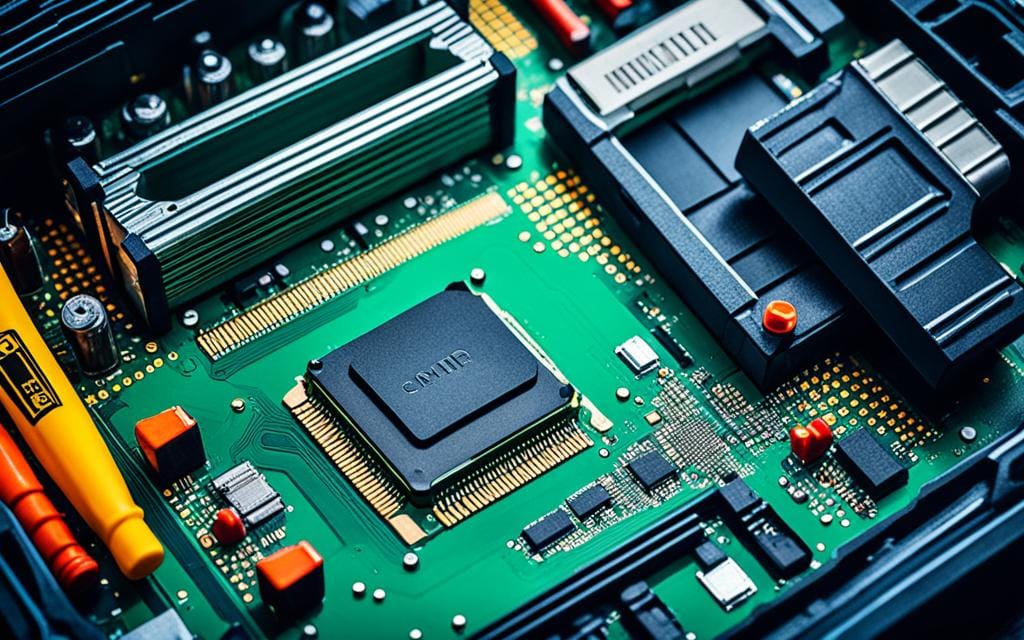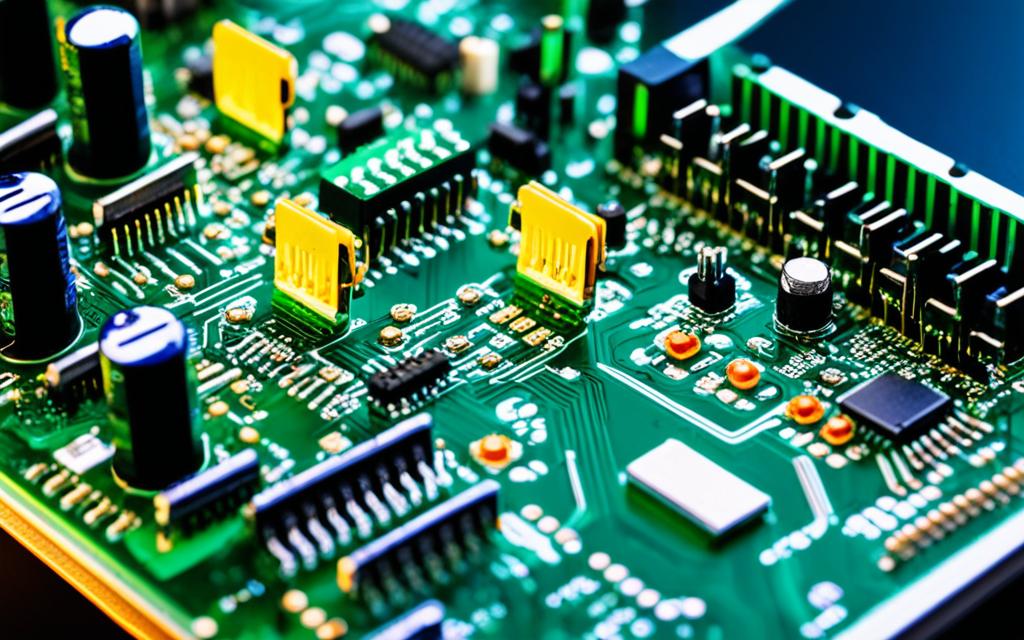Keeping your motherboard drivers updated is key for a smooth system. This guide will show you every step to update them. You can do it by hand or with special software.
By doing this, your motherboard will avoid problems from old drivers. It will work better and stay stable.
Table of Contents
ToggleWhat are Motherboard Drivers?
Motherboard drivers are like messengers in a computer. They help the motherboard and the operating system talk to each other. This is important for making sure that the computer works smoothly and all parts play nice.
Understanding the Importance of Motherboard Drivers
Think of motherboard drivers as translators for your computer. They make it possible for hardware like the processor and memory to work with the computer’s software. Without the right drivers, you could face problems like your computer crashing or not performing well.
Common Types of Motherboard Drivers
There are several types of important motherboard drivers. Some of these include chipset drivers, USB drivers, and audio/sound drivers. Each kind helps a specific part of your computer work the best it can.
- Chipset drivers: These help the CPU talk to the memory, storage, and other devices on the motherboard.
- USB drivers: They make sure USB ports and devices work like they should.
- Audio/Sound drivers: Without them, your computer wouldn’t be able to play music or sound from videos well.
- VGA/GPU drivers: These help the motherboard and the graphics card understand each other, making images look great on your screen.
- Storage drivers: They let storage devices, like hard drives and SSDs, work with the computer.
- Network drivers: These are needed for your computer to connect to the internet and other networks.
It’s very important to keep all your motherboard drivers up to date. This can help prevent your computer from crashing or having other problems. By doing this, your computer will run smoothly and be secure.
Identifying Your Motherboard Model
To update your motherboard drivers, you first need to know your motherboard’s model. This helps you download the right updates from the maker’s site. Luckily, finding your motherboard model isn’t hard.
One way is to look for the model name or number on the motherboard itself. It’s usually printed on there. If it’s not, the System Information tool on your computer can also show your motherboard model.
- Open the System Information tool. On Windows, find it by searching the Start menu.
- Check the “Motherboard” section. It should list the motherboard’s manufacturer and model.
CPU-Z is another tool that can help. It’s free and tells you a lot about your computer’s heart, including the motherboard’s make and model.
| Method | How to Use | Benefits |
|---|---|---|
| Physical Inspection | Look for the model name or number on the motherboard | An easy way to find the motherboard’s model |
| System Information Tool | It shows details like the motherboard model | Gives a lot of info about the computer’s hardware |
| CPU-Z | Just download and run the CPU-Z app | Tells you everything, including the motherboard’s make and model |
Use any of these ways to discover your motherboard model. This is key to getting the right driver updates. Remember, making sure you have the motherboard model correct is crucial for a smooth update.
Updating Motherboard Drivers Manually
Update motherboard drivers by downloading the latest ones from your computer’s maker. This way, you control how they’re installed. It keeps everything working smoothly with your computer.
Step-by-Step Guide for Manual Driver Updates
Here are the steps to manually update your motherboard drivers:
- Find out which motherboard model you have. Look at the motherboard’s label or check your computer’s documents.
- Go to the website of your motherboard’s manufacturer, like ASUS, Gigabyte, or MSI.
- Look for the page where you can download drivers for your specific model.
- Download the newest drivers for key parts of your motherboard. These include chipset, USB, audio, VGA, and network drivers.
- Next, install the drivers by following the instructions.
Manually updating motherboard drivers helps your computer run better. It makes sure your computer has the newest and best drivers. This can make your computer faster and work better with new items and software.
| Driver Type | Description |
|---|---|
| Chipset Driver | Supports the main parts of your motherboard, making your system work well. |
| USB Driver | Makes sure your USB ports and the things plugged into them work right. |
| Audio Driver | Boosts your sound system’s quality and features. |
| VGA Driver | Enhances the visuals and features of your motherboard’s video system. |
| Network Driver | Helps your network connection on your motherboard work well, wired or wireless. |
Updating Drivers via Windows Update
Updating your motherboard drivers through Windows Update is both easy and helpful. This tool is made to find and add the newest driver updates for your PC. This includes updates for your motherboard.
To update with Windows Update, head to Windows Settings. Then, click on Update & Security and Windows Update. After that, choose “Check for updates.” Windows will search and apply any available updates, including for your motherboard.
While using Windows Update is handy, it might not give you the very latest drivers. For the newest and best drivers, you should also check the manufacturer’s site. Or, consider using special driver update software.
- Go to the Windows Settings > Update & Security > Windows Update
- Click “Check for updates”
- Windows will scan and install any new driver updates, like motherboard ones
Using Windows Update makes keeping your drivers current easy. But remember to check the manufacturer’s site regularly. This ensures you get top-notch performance and stability from your system.
how to update the motherboard drivers
Keeping your motherboard drivers up-to-date is key for your computer’s best performance. Download the drivers straight from the manufacturer’s website. We will show you the steps to get the latest drivers for your motherboard.
Navigating the Manufacturer’s Website
Start by going to your motherboard brand’s website, like ASUS, Gigabyte, or MSI. Look for the support or downloads section. You can usually find a search tool there. Enter your motherboard’s model or serial number to get the latest driver updates.
Downloading and Installing the Latest Drivers
Once you find the right drivers for your motherboard, download them. Be sure to get the drivers for all parts, like the chipset, USB, audio, VGA, and network. After downloading, install the drivers by following the instructions.
Updating your motherboard drivers directly from the website ensures you get the best and most compatible versions. Although this method is more hands-on, it guarantees your computer’s stability and performance better than other tools.

Using Driver Update Software
A driver update software tool helps without searching for drivers manually. It scans your system for outdated drivers. If it finds any, it installs the newest ones for you. Always be cautious, and download from trusted sources.
Popular Driver Update Tools
Here are some well-loved driver update software:
- Driver Easy – It finds outdated drivers and updates them with a single click. It can work with many devices and systems.
- Driver Booster – It has a large database to quickly spot and update every driver, even for your motherboard.
- DriverMax – It’s easy to use and keeps your computer’s drivers in top shape.
These tools are great for keeping your drivers current. But, make sure to only get updates from trusted places to keep your system safe.
| Driver Update Tool | Key Features | Pricing |
|---|---|---|
| Driver Easy |
|
Free version available, paid plans start at $29.95/year |
| Driver Booster |
|
Free version available, paid plans start at $22.95/year |
| DriverMax |
|
Free version available, paid plans start at $29.95/year |
Using these tools will keep your system running smoothly. Your computer will work better and have fewer problems.
Troubleshooting Driver Update Issues
Updating motherboard drivers is usually easy. But sometimes, things don’t go as planned. This guide looks at common issues and their solutions.
Common Installation Errors
Feeling stressed about an error message while updating drivers? Don’t worry, it’s often fixable. Start by redownloading the driver; the file might be corrupt. If that doesn’t work, turn off your antivirus or firewall temporarily.
Handling Boot Failures After Updates
- If your computer won’t boot after an update, go into safe mode first.
- In safe mode, roll back the driver upgrade. This can fix conflicts or errors from the update.
- Always make a system restore point before driver updates. It helps to easily go back to the settings you had before.
| Issue | Troubleshooting Steps |
|---|---|
| Installation Errors |
|
| Boot Failures After Updates |
|
Following these steps should help you deal with many driver update problems. This way, you can make the process of updating motherboard drivers smooth and trouble-free.
Why Update Motherboard Drivers?
Updating your motherboard drivers keeps your computer running smoothly and reliably. Old drivers can slow down your system, cause software issues, and even crashes. By staying current, your computer works better. This is because its parts can talk to each other and the system the right way.
Updating drivers can make your computer faster and more responsive. This is because new drivers come with improvements and fixes. You’ll see a big difference, especially when using heavy software or playing games.
Also, updated drivers make sure everything works with the latest software. This means you won’t run into annoying compatibility problems. Your computer will run smoothly, without any hiccups.
It’s also important for preventing crashes and errors. Old drivers can mess things up, leading to system failures or data loss. Updating your drivers reduces these risks, making your computer safer and more stable.
| Benefits of Updating Motherboard Drivers | Potential Consequences of Outdated Drivers |
|---|---|
|
|
By updating your motherboard drivers regularly, you enjoy a computer that’s faster and more reliable. This ensures you get the most out of your computer investments.
Best Practices for Driver Updates
It’s essential to update your motherboard drivers regularly. This ensures your system runs smoothly and efficiently. With technology always changing, following the right steps is key. These steps make sure your updates are safe and do what they’re supposed to.
Recommended Update Frequency
Experts recommend checking for motherboard driver updates every 3-6 months. This often means you’ll get the newest features and fix important issues. If your computer is having problems, you might need to update more often.
Ensuring Safe and Reliable Updates
Having a recent backup is a must before you update any drivers. This backup keeps your data safe if you need to undo the update. Plus, always download drivers straight from the manufacturer’s website. This avoids problems with security and makes sure the driver works well with your system.
Stick to a good plan for driver update timing and safety. It will make the whole process smoother. This not only boosts your computer’s performance. It also keeps your system safe and reliable.
Don’t forget about regular system backups. They’re extra security during the driver update process. With the right steps in place, updating your motherboard drivers becomes easy. Your computer will keep running smoothly.
Conclusion
It’s important to keep your motherboard drivers updated for a smooth computer experience. You can easily find your motherboard model and download drivers from the manufacturer’s site. Use driver update software to make this process easier. Remember to always download drivers from safe sources.
Updating your motherboard drivers frequently is key. It keeps your system performing well. Always stay updated with driver guides and solve any troubleshooting issues to boost system performance.
Now you have the steps and tools to update your motherboard drivers. With this knowledge, your computer will run better. Let’s make our systems work at their best with these updates.
FAQ
How can I make sure my motherboard is working properly?
To keep your motherboard running well, update its drivers regularly. There are two ways to do this. You can either get the drivers from the maker’s site or use a special tool.
What are motherboard drivers and why are they important?
Motherboard drivers help the motherboard and the computer talk to each other. They make sure everything works right. Drivers like those for USB, audio, and network help avoid problems.
How do I identify the model of my motherboard?
To find your motherboard’s model, look at the physical motherboard or use Windows tools. You can also use apps like CPU-Z. Knowing the model is key to getting the right updates.
How can I manually update my motherboard drivers?
To update your drivers manually, go to the motherboard maker’s site. Download the latest drivers for your motherboard. Then, install them by following the instructions.
Can I use Windows Update to update my motherboard drivers?
Yes, you can let Windows Update help with drivers. Just go to Settings > Update & Security. Click “Check for updates.” But, the drivers might not be the newest.
What is the best way to update my motherboard drivers?
Downloading drivers from the maker’s website is the best way. Go to your motherboard’s brand site, find your model, and download the latest drivers. Then, install them as instructed.
Can I use driver update software to update my motherboard drivers?
Tools like Driver Easy or Driver Booster can update drivers for you. They identify outdated drivers and install the latest ones. Just be careful where you get your drivers from.
What should I do if I encounter issues when updating my motherboard drivers?
If you run into problems updating, don’t worry. Try redownloading the driver if it doesn’t install correctly. If your PC struggles after an update, go into safe mode and undo the driver update. Always create a system restore point before updating.
Why is it important to keep my motherboard drivers up-to-date?
Keeping drivers current is crucial. It helps avoid performance drops, system crashes, and errors. Updated drivers make sure your hardware works smoothly with the software, improving your computer’s efficiency and security.
How often should I update my motherboard drivers?
Check for updates every 3-6 months, but more often if you notice problems. Make sure to back up your system before updating. Always get drivers from the manufacturer’s site to be safe.
















